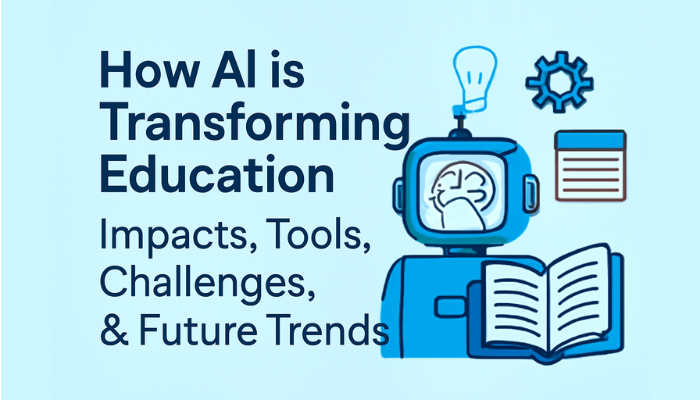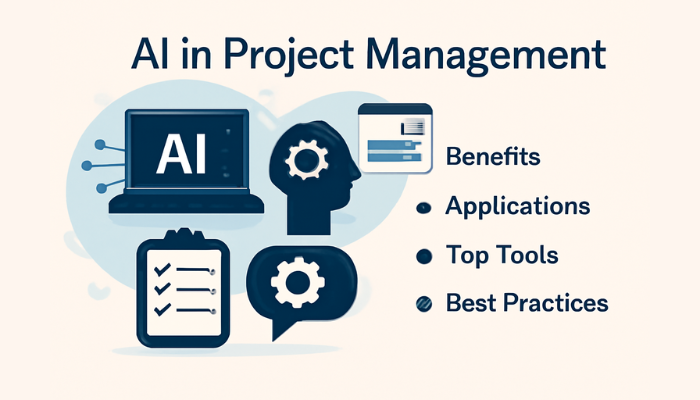Artificial Intelligence (AI) is becoming a key part of how education works today, helping to make both learning and teaching more effective. Whether you’re a tech professional, business leader, or developer, AI tools are changing the way industries improve efficiency, make decisions, and drive innovation. In fact, AI can greatly improve efficiency in areas like curriculum development and lesson planning, which make up 45% of a teacher’s duties.
In this blog, we’ll take a closer look at how AI is changing education. We’ll explore what AI in education means, its transformative impact on education, the best AI tools to use, and the challenges it brings, along with potential solutions. Finally, we’ll look at the future of AI in education and how it might continue to shape the way we teach and learn in the years to come.
What is Artificial Intelligence in Education?
Artificial Intelligence in education refers to the use of AI technologies to enhance the learning experience and improve teaching methods. It involves using algorithms, machine learning, and data analysis to create personalized, efficient, and interactive educational environments.
Now that you know about education and AI, let’s move on to how it’s impacting education.
Transformative Impacts of AI on Education
AI is making big changes in education, not only in how students learn but also in how teachers teach and manage classrooms. By helping both students and educators, AI creates a more personalized, efficient, and engaging learning experience. For educational institutions, this transformation can improve the quality of education, reduce administrative tasks, and make learning accessible to all.
1. Personalized Learning Paths
One of the most exciting ways AI is changing education is by personalizing learning for each student. AI analyzes a student’s strengths, weaknesses, and progress to tailor the lessons they receive. This ensures that students are never bored because they’re either repeating the same material or struggling to keep up with content that’s too difficult.
For example, AI can identify that a student is struggling with algebra but is doing well in geometry. Based on this, it will focus more on algebra by providing extra practice and support, while still keeping the student engaged in geometry. This personalized approach helps students improve at their own pace and keeps them motivated throughout their learning journey.
2. Instant Feedback and Intelligent Tutoring
AI offers immediate feedback on assignments, quizzes, and other activities, which is incredibly valuable for both students and educators. This means that students don’t have to wait days to know where they went wrong, they can fix mistakes right away and learn from them.
For instance, if a student answers a math question incorrectly, AI not only points out the mistake but also explains what went wrong and how to correct it. It’s like having a tutor who’s available 24/7. For educators, this instant feedback helps them identify which students need extra help and which areas of the curriculum may need more focus.
3. Automated Grading and Assessment
Grading can take up a lot of a teacher’s time, but AI can help by automating the process, especially for assignments like essays, quizzes, and short answers. This saves teachers a lot of time, allowing them to focus on more interactive and personalized teaching methods.
For example, AI can grade an essay by checking for grammar, sentence structure, and clarity, and then provide immediate suggestions for improvement. Teachers can then use the extra time to interact more with students, give in-depth feedback, and provide one-on-one support where needed.
4. Smart Content Creation
AI helps educational institutions create relevant and up-to-date learning materials. AI-powered systems can generate lesson plans, quizzes, flashcards, and other resources that match what students are learning in real-time. This ensures that students always have the latest content and materials to help them succeed.
For example, if students are learning about the American Revolution, AI can create quizzes and flashcards tailored to that topic, so students can quickly test their knowledge and reinforce what they’ve learned. This helps students stay engaged and makes studying more effective.
5. Support for Diverse Learners
AI is also helping students with diverse needs, including those with disabilities. It can offer speech-to-text or text-to-speech tools for students with hearing or visual impairments. Additionally, AI can track a student’s emotional response to lessons, offering extra support if they feel frustrated or stressed.
For example, if a student has trouble reading a passage due to dyslexia, AI can read the text aloud, highlighting each word as it’s spoken. This allows students to better follow along and understand the material, ensuring that everyone has the opportunity to succeed, regardless of their learning challenges.
6. Virtual Avatars and Language Support
AI-powered virtual avatars can break down language barriers, making education more accessible to international students or those who speak different languages. These avatars can deliver lessons in multiple languages, allowing students to learn in their native language.
For example, if a student is more comfortable in Spanish, an AI-powered virtual teacher can deliver the same lesson in Spanish, ensuring that the student understands the material. This can be particularly helpful in global education settings, where students from different backgrounds need to feel included and supported.
7. Administrative Efficiency
AI is streamlining administrative tasks in educational institutions, which helps reduce the workload for teachers and administrators. Tasks like tracking attendance, scheduling classes, and managing assignments can all be automated, allowing teachers to focus more on teaching and less on paperwork.
For instance, AI can automatically track student attendance and send reminders about assignments or exams, ensuring that everything runs smoothly. This reduces the time spent on administrative tasks and ensures that the institution can operate more efficiently.
8. Enhanced Student Support
AI tools like virtual assistants and chatbots provide students with continuous support, even outside of the classroom. These tools can help students with assignments, provide additional resources, or suggest study materials based on their progress.
For example, if a student is struggling with a particular subject, the AI can recommend articles, videos, or tutorials to help them better understand the topic. This 24/7 support ensures that students always have access to help, no matter what time of day it is.
9. Creative Opportunities
In creative fields such as art, design, and music, AI is opening up new opportunities for students to explore and develop their skills. AI tools can suggest different techniques, help students experiment with new ideas, and even generate creative work.
For example, if a student is learning digital painting, AI can offer suggestions on how to improve their artwork or introduce them to new styles to try. This encourages students to push their creative boundaries and think outside the box.
10. Inclusive and Scalable Education
AI makes education more scalable, meaning that more students can access quality learning experiences, no matter where they are. AI helps ensure that all students, even in remote or underserved areas, receive high-quality education that adapts to their needs.
For example, a student living in a rural area who doesn’t have access to a wide variety of teachers can benefit from AI-powered learning tools that provide the same level of personalized instruction that students in urban areas receive. This accessibility makes learning more equitable and ensures that everyone has the opportunity to succeed.
Want to discover the latest AI tools and their applications? Visit our blog on AI Software Tools and Use Cases in 2025 to stay up to date!
Now that you understand the transformative impact AI is having on education, it’s time to talk about the tools you can use.
Best AI Tools to Use in Education
By incorporating AI, educational institutions can offer more personalized, engaging, and efficient learning solutions. Here are some of the best AI tools that can transform education for students, educators, and institutions alike.
1. ChatGPT
In an educational institution, ChatGPT can serve as an intelligent assistant to support both students and teachers. This AI chatbot can help students with homework, research, and writing. It provides quick answers to questions, simplifies difficult topics, and assists in writing essays or reports. For educators, it can generate quizzes, study guides, and offer instant feedback on assignments.
Key Features:
- Instant Answers: Provides quick, conversational answers to questions.
- Simplifies Complex Topics: Breaks down difficult subjects into easy-to-understand explanations.
- Writing Assistance: Helps with writing and editing essays, reports, and emails.
- 24/7 Availability: Always available for students and teachers to access.
- Study Tools: Creates quizzes and study guides for exam preparation.
2. Quizlet
In any educational setting, Quizlet can be used as a powerful study tool that helps students learn through flashcards, quizzes, and interactive games. It adapts to each student’s learning style, ensuring that the study sessions are efficient and engaging. Institutions can use it to create custom study sets or tap into millions of pre-made sets.
Key Features:
- Automatic Study Set Creation: Generates study sets from notes or documents.
- Interactive Flashcards: Provides flashcards and games for more engaging learning.
- Personalized Study Sessions: Adapts to the student’s progress for better outcomes.
- Access to Shared Study Sets: Offers millions of study sets created by others.
- Gamified Learning: Adds fun to studying with features like Blast and Categories.
3. Socratic by Google
Socratic helps students solve homework problems by providing step-by-step solutions. They can type or take a picture of their question, and the app delivers detailed answers, accompanied by helpful graphics and videos to improve understanding. Educational institutions can leverage this tool to enhance learning across various subjects.
Key Features:
- Text and Image-Based Answers: Solves questions with both text and images.
- Step-by-Step Solutions: Offers clear and detailed solutions to problems.
- Helpful Visuals: Includes graphics and videos to aid in better understanding.
- Content Filtering: Ensures a safe learning environment by blocking inappropriate content.
- Student-Focused: Ideal for middle and high school students, making it an excellent resource in the classroom.
4. Carnegie Learning
Carnegie Learning is an AI-driven math platform that provides personalized lessons and feedback for students. The platform adapts to individual strengths and weaknesses, offering targeted support for difficult topics. It is ideal for use in both classroom settings and independent study. Institutions can utilize this tool to ensure students receive the help they need to succeed in math.
Key Features:
- Interactive Math Lessons: Personalized lessons based on individual learning needs.
- Real-Time Feedback: Instant feedback to guide students toward improvement.
- Progress Tracking: Monitors progress and adjusts lessons accordingly.
- Personalized Learning: Adapts to students’ strengths and areas that need improvement.
- Versatile Use: Supports both classroom learning and independent study.
5. SchoolAI
SchoolAI is a comprehensive platform that supports both teachers and students by providing real-time insights and AI-powered tutoring. This platform can enhance the learning environment by tracking student progress, offering customized tutoring, and ensuring a safe and efficient learning space. Educational institutions can use SchoolAI to boost engagement and provide tailored support to meet diverse learning needs.
Key Features:
- Real-Time Insights for Teachers: Provides data on student progress to teachers in real-time.
- Customizable AI Tutors: AI tutors tailored to specific subjects and student needs.
- Safety Monitoring: Monitors interactions to maintain a safe learning environment.
- Variety of Learning Tools: Offers a range of tools to support different learning styles.
- User-Friendly: Easy for both teachers and students to navigate.
You now have the tools to make the most of education and AI. But, like anything new, AI comes with its own set of challenges. Let’s explore those, and with solutions you can rely on.
Looking to build AI-powered tools for your educational institution?
Codewave specializes in smart, student-focused solutions. Contact Us to get started today.
Challenges of AI in Education with Solutions
AI can improve learning in many ways, but there are also a few problems that schools and colleges need to solve. These challenges can affect both students and teachers. Below are some of the most common issues and simple solutions that educational institutions can follow.
- Keeping Student Data Safe
When students use AI tools, the system collects a lot of personal data like test scores, learning habits, and performance. If this data is not protected well, someone might misuse it or access it without permission.
Solution: Educational institutes should use safe and trusted technology. They must follow privacy laws and protect data using passwords, encryption, and security systems. It’s important to work with technology companies that take student safety seriously.
- Not All Students Have Access to Technology
Some students do not have smartphones, tablets, or internet at home. This is common in rural areas or for families with low income. These students may fall behind because they can’t use AI tools like others.
Solution: Educational institutes and universities can provide free access to computers, the internet, or learning labs. They can also give affordable devices to students or work with the government and NGOs to offer digital support to everyone.
- Teachers Not Trained to Use AI
Many teachers are not fully trained to use AI in the classroom. Some may feel unsure or scared to try new tools. This can make it hard for students to get the right help or benefit from AI-based learning.
Solution: Educational institutes should arrange regular training sessions for teachers. Simple workshops, online courses, and expert support can help teachers understand how to use AI in teaching and feel more confident.
- Bias in AI Tools
Sometimes, AI systems are built using limited data. If the data doesn’t include all types of students, the system may treat some students unfairly. For example, it might give wrong feedback or ignore individual needs.
Solution: Educational institutes must choose AI tools that are tested on different types of students. They should ask tech companies to use fair and balanced data and check the results often to make sure no student is left out.
AI is all around us, but what’s making it so popular? Our blog, “Why AI is Getting Trendy: Key Reasons Behind Its Popularity”, explains the main reasons why AI is growing and becoming a big trend.
So, now that we’ve addressed the challenges and solutions, let’s explore the exciting future trends of AI in education.
Future Trends of AI in Education
As AI continues to shape the education sector, several trends are expected to redefine how you learn and how teachers teach. Here’s a look at what the future holds for AI in education:
- Virtual and Augmented Reality Integration
AI will work alongside Virtual and Augmented Reality (VR/AR) to create immersive learning experiences. Imagine being able to take a virtual tour of ancient Egypt or experiment with chemical reactions in a lab without leaving the classroom. This combination of AI and AR/VR will make learning more interactive and engaging.
- Smarter Administrative Tools
AI will continue to automate administrative tasks like grading and scheduling, freeing up more time for teachers to focus on you. In the future, AI will handle even more complex tasks, such as managing lesson plans and tracking overall student progress, allowing teachers to better address individual learning needs.
- Greater Accessibility for All Learners
AI will make education more accessible for everyone, including those with disabilities. Future advancements will include more AI-driven assistive technologies, such as real-time translation for students who speak different languages, or more advanced tools to support students with learning disabilities.
- Ethical AI in Education
As AI becomes more integrated into education, ethical concerns about privacy and bias will need to be addressed. In the future, AI systems will be designed to be more transparent, ensuring fairness and data protection while also adhering to regulations that protect students’ rights.
Having understood the future direction of AI in education, let’s discover how Codewave is playing a key role in transforming education with AI solutions.
Codewave: Your Partner in Transforming Education with AI
At Codewave, we’re helping educational institutions shape the future of learning with AI-powered, personalized, and collaborative tools. Our focus is on making learning experiences more engaging, accessible, and practical, both inside and outside the classroom.
By combining Artificial Intelligence (AI) and Machine Learning (ML), we bring real-life context into digital learning, helping institutions support every learner’s unique journey. You can check out our portfolio to see how we tackle real-world challenges and experience our work.
Here’s how we support the education sector:
- Digitization of Course Content & Question Banks: We convert traditional learning material into digital formats, so institutions can make it easily accessible through web or mobile platforms.
- E-Learning App Development: We build interactive mobile apps that include video lessons, quizzes, and practice tests. These apps allow students to learn anytime, from anywhere, at their own pace.
- Digital Transformation Services: We help institutions go digital with web, mobile, and tablet-based platforms that support daily learning, administration, and communication.
- Online Mock Exams & Progress Tracking: Our tools allow students to take mock exams online and receive detailed progress reports. Teachers and administrators can also track performance and identify areas for improvement.
- School Management Systems: We offer comprehensive platforms that streamline teacher-student communication, timetable planning, attendance tracking, and overall school administration.
- Custom Software Development: We design tailored solutions based on each institution’s unique goals, whether it’s a learning platform, assessment engine, or collaboration tool.
- Board & Competitive Exam Preparation Apps: We create digital tools that help students prepare for board exams and entrance tests, with practice papers, study guides, and performance insights.
- Psychometric Assessments: We offer tools that assess emotional and social well-being. These insights help educators understand student behavior, mental health, and areas where support is needed.
- AI-Based Adaptive Learning Apps: We develop learning platforms powered by AI that adjust the content based on each learner’s performance and progress.
- Social Learning Enablement: We build collaborative platforms where students can learn from each other, share resources, and discuss ideas, turning learning into a community experience.
- Large-Scale Content Production & Distribution: We help institutions produce, manage, and distribute digital learning content across regions and platforms, ensuring effective delivery to all learners.
- Learner-to-Mentor Connect Platforms: We design mentor-matching systems that connect students with experienced guides for academic, career, and personal development support.
Ready to See It in Action? Book a demo with us. Get a first-hand look at how Codewave’s innovative solutions are transforming education.
Codewave is a UX first design thinking & digital transformation services company, designing & engineering innovative mobile apps, cloud, & edge solutions.







